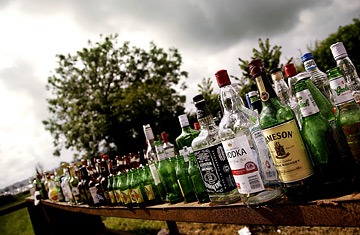
Empty bottles of alcohol
I was driving up the Massachusetts Turnpike one evening last February when I knocked over a bottle of water. I grabbed for it, swerved inadvertently--and a few seconds later found myself blinking into the flashlight beam of a state trooper. "How much have you had to drink tonight, sir?" he demanded. Before I could help myself, I blurted out an answer that was surely a new one to him. "I haven't had a drink," I said indignantly, "since 1981."
It was both perfectly true and very pertinent to the trip I was making. By the time I reached my late 20s, I'd poured down as much alcohol as normal people consume in a lifetime and plenty of drugs--mostly pot--as well. I was, by any reasonable measure, an active alcoholic. Fortunately, with a lot of help, I was able to stop. And now I was on my way to McLean Hospital in Belmont, Mass., to have my brain scanned in a functional magnetic-resonance imager (fMRI). The idea was to see what the inside of my head looked like after more than a quarter-century on the wagon.
Back when I stopped drinking, such an experiment would have been unimaginable. At the time, the medical establishment had come to accept the idea that alcoholism was a disease rather than a moral failing; the American Medical Association (AMA) had said so in 1950. But while it had all the hallmarks of other diseases, including specific symptoms and a predictable course, leading to disability or even death, alcoholism was different. Its physical basis was a complete mystery--and since nobody forced alcoholics to drink, it was still seen, no matter what the AMA said, as somehow voluntary. Treatment consisted mostly of talk therapy, maybe some vitamins and usually a strong recommendation to join Alcoholics Anonymous. Although it's a totally nonprofessional organization, founded in 1935 by an ex-drunk and an active drinker, AA has managed to get millions of people off the bottle, using group support and a program of accumulated folk wisdom.
While AA is astonishingly effective for some people, it doesn't work for everyone; studies suggest it succeeds about 20% of the time, and other forms of treatment, including various types of behavioral therapy, do no better. The rate is much the same with drug addiction, which experts see as the same disorder triggered by a different chemical. "The sad part is that if you look at where addiction treatment was 10 years ago, it hasn't gotten much better," says Dr. Martin Paulus, a professor of psychiatry at the University of California at San Diego. "You have a better chance to do well after many types of cancer than you have of recovering from methamphetamine dependence."
That could all be about to change. During those same 10 years, researchers have made extraordinary progress in understanding the physical basis of addiction. They know now, for example, that the 20% success rate can shoot up to 40% if treatment is ongoing (very much the AA model, which is most effective when members continue to attend meetings long after their last drink). Armed with an array of increasingly sophisticated technology, including fMRIs and PET scans, investigators have begun to figure out exactly what goes wrong in the brain of an addict--which neurotransmitting chemicals are out of balance and what regions of the brain are affected. They are developing a more detailed understanding of how deeply and completely addiction can affect the brain, by hijacking memory-making processes and by exploiting emotions. Using that knowledge, they've begun to design new drugs that are showing promise in cutting off the craving that drives an addict irresistibly toward relapse--the greatest risk facing even the most dedicated abstainer.
"Addictions," says Joseph Frascella, director of the division of clinical neuroscience at the National Institute on Drug Abuse (NIDA), "are repetitive behaviors in the face of negative consequences, the desire to continue something you know is bad for you."
Addiction is such a harmful behavior, in fact, that evolution should have long ago weeded it out of the population: if it's hard to drive safely under the influence, imagine trying to run from a saber-toothed tiger or catch a squirrel for lunch. And yet, says Dr. Nora Volkow, director of NIDA and a pioneer in the use of imaging to understand addiction, "the use of drugs has been recorded since the beginning of civilization. Humans in my view will always want to experiment with things to make them feel good."
That's because drugs of abuse co-opt the very brain functions that allowed our distant ancestors to survive in a hostile world. Our minds are programmed to pay extra attention to what neurologists call salience--that is, special relevance. Threats, for example, are highly salient, which is why we instinctively try to get away from them. But so are food and sex because they help the individual and the species survive. Drugs of abuse capitalize on this ready-made programming. When exposed to drugs, our memory systems, reward circuits, decision-making skills and conditioning kick in--salience in overdrive--to create an all consuming pattern of uncontrollable craving. "Some people have a genetic predisposition to addiction," says Volkow. "But because it involves these basic brain functions, everyone will become an addict if sufficiently exposed to drugs or alcohol."
That can go for nonchemical addictions as well. Behaviors, from gambling to shopping to sex, may start out as habits but slide into addictions. Sometimes there might be a behavior-specific root of the problem. Volkow's research group, for example, has shown that pathologically obese people who are compulsive eaters exhibit hyperactivity in the areas of the brain that process food stimuli--including the mouth, lips and tongue. For them, activating these regions is like opening the floodgates to the pleasure center. Almost anything deeply enjoyable can turn into an addiction, though.
